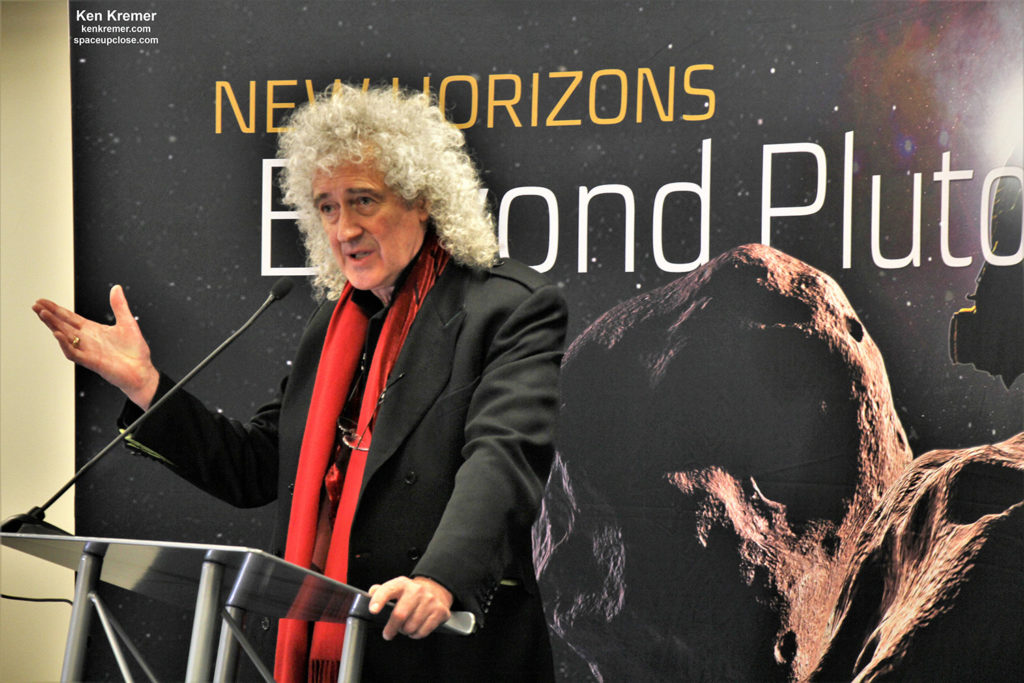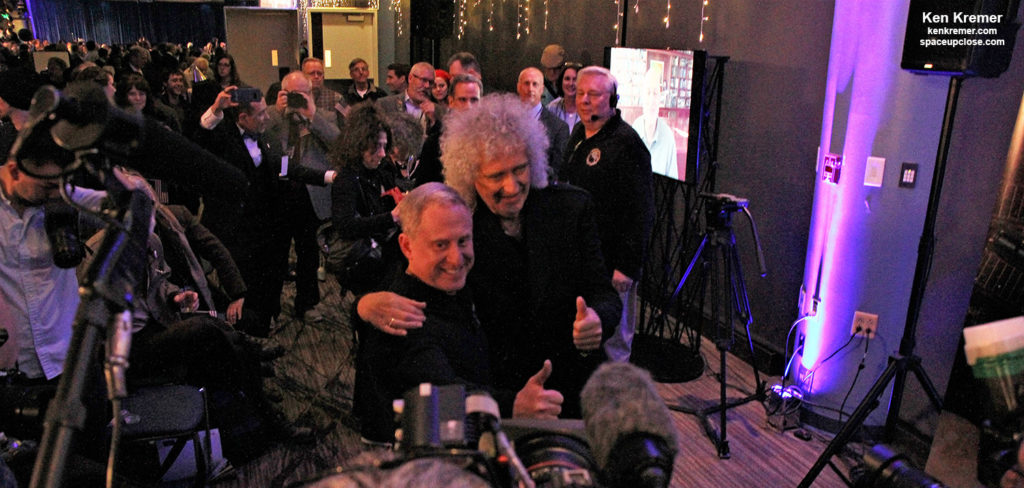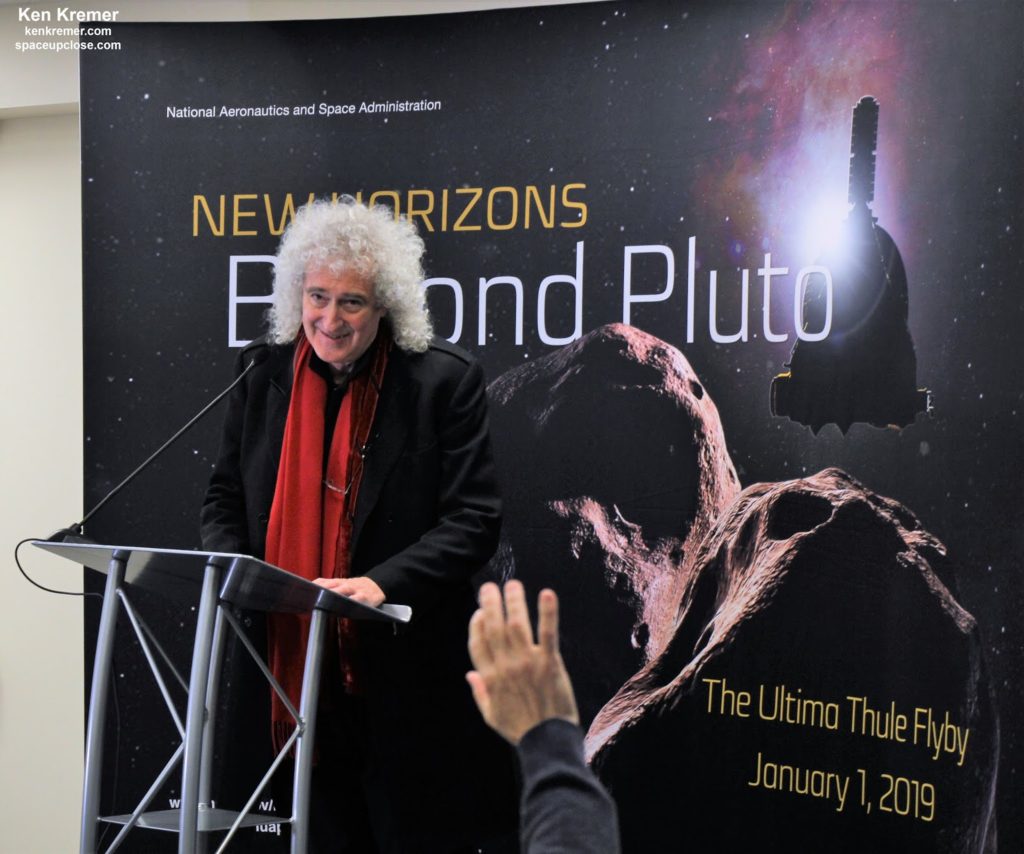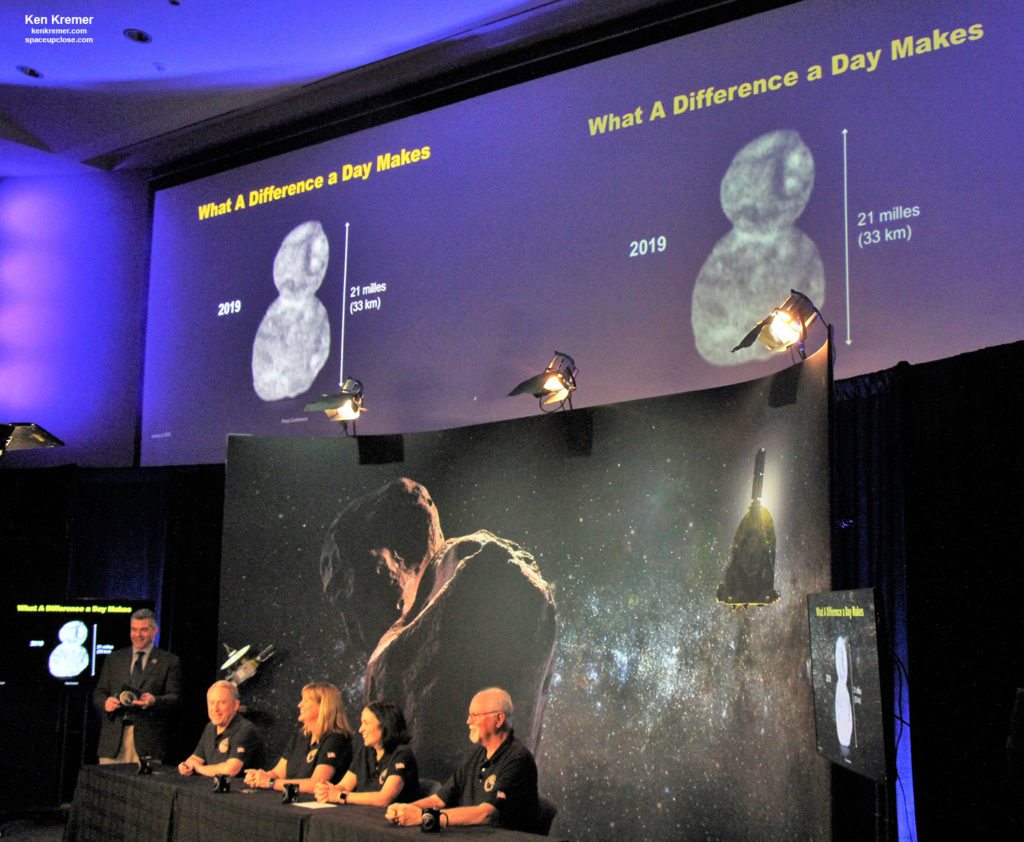Video Caption: Brian May – New
Horizons (Ultima Thule Mix) [Official Music Video]. Celebrating the whole 13-year Journey of New Horizons probe.
This is Brian’s personal tribute to the on-going NASA New Horizons mission,
which on New Years Day 2019 achieved the most distant spacecraft flyby in
history at Ultima Thule. Credit: Brian
May
Ken Kremer —SpaceUpClose.com &
RocketSTEM –6 January 2019
JOHNS HOPKINS UNIVERISTY APPLIED PHYSICS LABORATORY, LAUREL,
MD – Legendary rock star Dr. Brian
May, lead guitarist for the world famous rock band Queen who is also an official
member of the New Horizons science team, lent his considerable luster to the groundbreaking
NASA mission by composing a new song and rocking music video in tribute to the mission “and the need for mankind to explore” – coinciding
with the fast flyby of ‘Ultima Thule’ a miniscule far flung rock dating to the dawn of
our solar system. The
timely tune is named simply ‘New Horizons.’ It
was released worldwide online at the stroke of midnight 2019 – but first to the team live by May himself personally present at Johns
Hopkins University Applied Physics Laboratory!
May – a Ph.D. astrophysicist
– created the music video and wrote the song especially for the New Years Day
2019 flyby of Ultima Thule – the farthest object ever visited – by NASA’s New Horizons spacecraft at the request of Principal Investigator Dr. Alan
Stern.
“This
mission is about human curiosity,” May said at a media briefing at the Johns
Hopkins University Applied Physics Laboratory (JHU APL), in Laurel, MD just hours
before the Jan. 1 flyby. “Its about the need for mankind to explore and see and discover what
makes the universe tick. So
my song is an anthem about the human spirit and endeavoring to discover the
universe.”
Enjoy the Brian May video above.
premiered the astronomically awesome song especially during the New Years midnight
Monday night countdown celebration with his personal exuberant commentary in
front of hundreds of team members, guests and media gathered at JHU APL leading
up to the 12:33 a.m. EST flyby of Ultima Thule.
Ultima
Thule is the most distant and most primitive object ever explored up close by an emissary from
humanity – a small icy rock in the Kuiper Belt located some 1 Billion miles (1.6
Billion km) beyond Pluto and orbits 4.1 Billion miles (6.6 Billion km) from the
Sun and the Earth.
It
was discovered to be a ‘contact binary’ and counts as the first planetesimal
ever visited and sort of like traveling in a time machine to the birth of our
solar system.
“Alan
[Stern] called me about five months ago and said ‘Can you make some music for
the Ultima Thule flyby?” May explained at the Dec. 31 pre-flyby briefing.
“And
I thought this is probably going to be hard because I can’t think of anything
that rhymes with ‘Ultima Thule’,” he
joked to laughter.
“So
I had a doubt in my mind but then it went away and I could hear some music
playing in my mind, of an object plummeting through space faster than anything
ever launched away from Earth – and I got kind of inspired!”
“But
I didn’t have a lyric. And then it gradually dawned on me.”
mission is about human curiosity. It’s
about the need for mankind to explore and discover what makes the universe
tick. And this has been going on since the dawn of time.”
“So my song is an anthem about the
human spirit and endeavoring to discover the universe!” May
explained.
May’s friend Don
Black, songwriter of the iconic tune “Born Free” about nature was inspired as
well and offered May two very simple verses as ideas for the song.
“New Horizons
to explore” & “New Horizons that we’ve never seen before!”
That evolved
into the song that May and Black eventually wrote.
“The song is
an anthem to human endeavor.”
The flyby countdown event was attended by hundreds of New
Horizons team members, invited guests and the media including Space UpClose at the Johns Hopkins University Applied
Physics Laboratory (JHU APL), in Laurel, MD.
Enjoy my photos.
 |
|
Celebrating New Horizons mission New Year’s Day 2019 flyby of Ultima Thule team member Dr. Brian May (Queen lead guitarist) debuts his
new astronomically awesome song ‘New Horizons’ at JHU APL urging ‘the need for mankind to explore space’ as the spacecraft explores the furthest/coldest object ever visited by human emissary. Credit: Ken Kremer/kenkremer.com/spaceupclose.com |
May
and Stern hugged and gave two big thumbs up at the conclusion of the music
video premier at JHU APL.
Personally I thought the pulse pounding music rocked and the imaginative and accurately detailed video vividly illustrated the entire mission in a most wonderful way– starting
with the launch on a ULA Atlas V in 2006 amplified by the striking voice of famed
astronomer Steven Hawking and then voyaging outwards for earlier flybys past Jupiter
and Pluto and concluding with the Ultima Thule encounter.
“The
revelations of New Horizons may help us better understand how our solar system
was formed!” says Hawking in his synthesized voice near the beginning of the video.
To
date its gotten about 1 million views !!!
The
Atlas V launched New Horizons as the ‘Fastest Spaceship ever into the Unknown’ … and ‘The First Mission to the Last Planet!’
May
received his doctorate in astrophysics from Imperial College London in 2007. The
topic was zodiacal dust.
Dr. Brain May also plays a science role in the New Horizons mission
as a team member working on the 3 D images of Ultima Thule. He created a left
and right stereo image pair based on these initial two LORRI images – see
below.
“The Prize !! For those of us who waited with bated breath
for the Ultimate Stereo of Ultima Thule …,” Brian May wrote on his social media
pages.
I spoke with Brain May at a pre-flyby JHU APL briefing about
how using 3D imagery greatly helps increase public awareness and support for
space exploration and science.
The baby grand piano shaped New Horizons spacecraft flew
past Ultima Thule within a distance of merely 2,200 miles (3,500 kilometers) while approaching
at a velocity of 32,000 mph (9 miles per second).
It gathered about 50 GB of data including imagery,
spectroscopy and research measurements using its 7 on board science instruments.
“Ultima Thule” is
an unchanged fossil remnant and planetesimal formed during the dawn of our
solar system some 4.5 Billion Years ago.
Planetesimals are
the tiny building blocks from which much larger structures like moons and
planets are born by accretion of hordes of bits of matter over time.
The bi-lobal rock is shaped remarkably like a ‘snowman’ and
consists of two connected balls roughly spherical in appearance.
The new world measures 19 miles (31 kilometers) in length.
The team has unofficially nicknamed the larger sphere “Ultima” (12
miles/19 kilometers across) and the smaller sphere “Thule” (9
miles/14 kilometers across).
Watch
for Ken’s continuing onsite coverage direct from JHU APL.
Watch
for Ken’s continuing onsite coverage of NASA, SpaceX, ULA, Boeing, Lockheed Martin,
Northrop Grumman and more space and mission reports direct from the Kennedy Space
Center, Cape Canaveral Air Force Station, Florida and Wallops Flight Facility,
Virginia.
and human spaceflight news: www.kenkremer.com –www.spaceupclose.com – twitter
@ken_kremer – email: ken at kenkremer.com
journalist and photographer based in the KSC area.
Ken’s photos are for sale and he is available for lectures and outreach events









